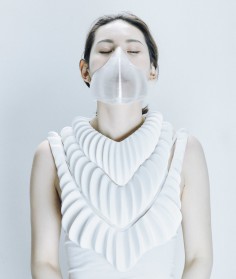JUN KAMEI

source:3dersorg
Amphibio, the two-part 3D-printed accessory consists of a gill and a respiratory mask, is designed specifically for a future in which humankind lives in very close proximity with water. “By 2100, a temperature rise of 3.2 degrees celsius is predicted to happen, causing a sea-level rise affecting between 500 million and three billion people, and submerging the megacities situated in the coastal areas,” he explained.
The gill accessory is 3D printed from a microporous hydrophobic material, which allow air to pass through, but stop any water from penetrating it. The system is able to extract oxygen from the surrounding water, and release carbon dioxide that accumulates in the system.Inspired by the gills of a fish, its creator hopes the design could help mankind cope with rising sea levels and spent more time underwater.
“The technology was inspired from water diving insects which survive underwater by virtue of a thin layer of air trapped on their superhydrophobic skin surface, working as a gas exchanging gill,” he said. “The newly developed material can be shaped in complex forms using recent additive manufacturing technologies, such as 3D printing.”
“It provides daily comfort to people who spend as much time in the water as on the land,” Kamei said. The system currently does not produce enough oxygen to sustain human breathing, but Kamei is planning to test AMPHIBIO to support underwater breathing at human scale, where a gill with at least 32 m2 would be required to support our oxygen consumption in water.
“If you are familiar with free diving and scuba diving equipment, Amphibio sits right in between those two,” Kamei added. “In a near future, it could allow the wearer to stay underwater longer than in free diving, but with less equipment than scuba diving.”
Kamei is graduating from RCA with an MA in Innovation Design Engineering. He embarked on the project in collaboration with RCA-IIS Tokyo Design Lab, an international collaborative initiative between RCA and the University of Tokyo.
.
.
.
.
.
.
.
source:bigumigucom
Jun Kamei’nin geliştirdiği amfibik aksesuar, geleceğe yönelik karanlık senaryolara karşı çözüm öneriyor. Deniz canlılarındaki solungaçlara benzer şekilde çalışan Amphibio adlı su altı aksesuarı, su seviyeleri yükseldiğinde ve yaşam alanlarımız sular altında kaldığında insanın hayatta kalmasını amaçlıyor.
Ana akım medyada dahi rastlamışsınızdır, iklim değişikliği nedeniyle gelecekte dünyanın pek çok yerinin sular altında kalacağı öngörülüyor. Doğadaki canlıları örnek olarak tasarımlar yapan Jun Kamei, bu durum karşısında kayıtsız kalmamış. Kamei, Amphibio‘yu tasarlarken o günler gelip çattığında insanların suda daha fazla zaman geçirmek zorunda kalacağı gerçeğinden hareket etmiş. Ancak bu distopik senaryodaki olumsuz tarafa saplanıp kalmak yerine o durumda insanları nasıl özgürleştirebileceğine, suda da karadaki kadar nasıl rahat hareket edilebileceğine odaklanmış. Böylece Amphibio ortaya çıkmış. Amphibio su altında nefes alıp verebilmek için geliştirilmiş, bir parçanız gibi hissettirecek 3B baskı bir solunum cihazı. Cihaz, maske ve solungaç gibi çalışan kısım olmak üzere iki bölümden oluşuyor.
Kraliyet Sanat Koleji’nde eğitimini tamamlayan, Londra ve Tokyo arasında çalışmalarını sürdüren Japon tasarımcı Kamei, ürünün bir prototipini üretmiş ancak ürünü geliştirmeye devam ediyor. Şu an için Amphibio insanın nefes alıp vermesine yetecek seviyede oksijen üretmiyor ancak bu potansiyele sahip. Hatta şu anda küçük bir gaz tankı ile desteklendiğinde işlev görür hale geliyor.
Boynu ve göğsü sarmalayan kısım, solungaç olarak işlev görüyor. Mikro gözenekli hidrofobik (su geçirmez) malzeme, sudaki oksijeni alıyor ve bir boru aracılığıyla maske üzerinden insana hava sağlıyor. Malzemedeki mikroskobik gözenekler havanın geçmesine izin veriyor ancak suyun içeri nüfuz etmesine izin vermiyor. Kamei, sistemi süperhidrofobik ciltleri sayesinde suda hayatta kalabilen böceklerden ilham alarak geliştirmiş. Kamei’ye göre Amphibio, serbest dalış ve tüplü dalış deneyimi arasında bir yerlerde.
.
.
.
.
.
.
.
source:fpiecp
Jedna z dystopijnych wizji przyszłości zakłada, że do 2100 roku temperatura wzrośnie o 3.2 stopnie Celsjusza, doprowadzając do masowego topnienia lodowców i podniesienia się poziomu wody. Jun Kamei ma jednak sposób na to, jak przetrwać w nowej, podwodnej rzeczywistości.
Amphibio to projekt absolwenta prestiżowej Royal College of Art. Składa się z pancerza nakładanego na ciało oraz z maski wykonanej ze specjalnie opracowanego materiału.
Pozwala na pobieranie tlenu z wody, a następnie na wydalanie dwutlenku węgla. Mikroskopijne pory przepuszczają tlen, ale nie pozwalają na przepuszczenie wody do wnętrza maski. Dzięki temu możliwe jest komfortowe oddychanie pod powierzchnią wody.
Amphibio zostało zainspirowane przez podwodne zwierzęta, których organizm i budowa funkcjonuje na tej samej zasadzie, co projekt Kamei. Student RCA zdołał opracować technologicznie zaawansowany materiał, który powstaje za pomocą drukarki 3D. Jak sam przewiduje, technologia ta wkrótce będzie dostępna na masową skalę, co umożliwi tańszą i powszechną produkcję projektów podobnych do Amphibio. Jego zdaniem ludzkość musi się szybko dostosować do zmieniających się warunków, a jedną z odpowiedzi na przyszłe potrzeby jest właśnie projekt maski i pancerza umożliwiającego życie pod wodą.
Chociaż Amphibio to na razie jedynie prototyp, który jeszcze nie umożliwia samodzielnego oddychania bez pomocy małego baku z gazem, nie jest wykluczone, że większe instytucje zainteresują się projektem Kamei. Teorie na temat niedalekiej przyszłości ludzkości nieraz się wykluczają i są sobie sprzeczne, z pewnością warto jednak przygotować się na te z nich, których prawdopodobieństwo wzrasta z każdą dekadą.

